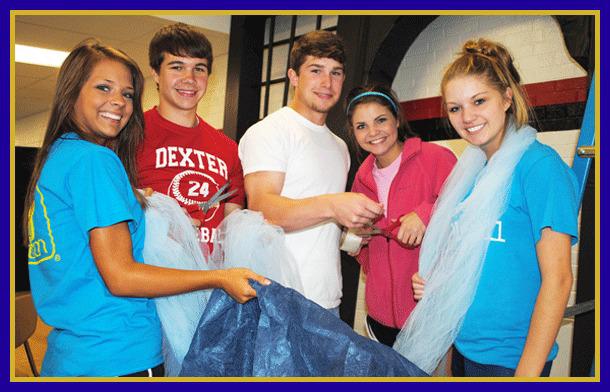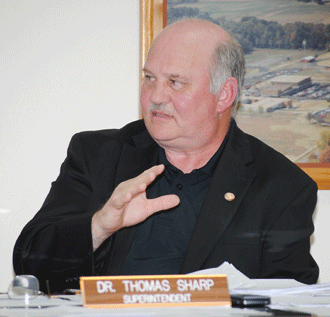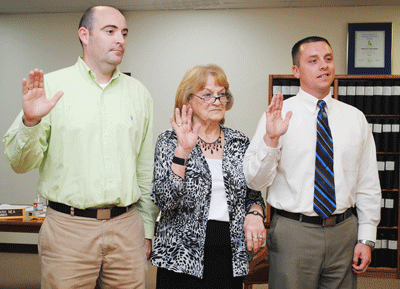Local News
Prom 2011: A Spring Journey To Paris
April 15th 2011 by News

By Annabeth Miller
ShowMe Times Editor
Junior class members were busy all day Friday in transforming the auditorium, lobby and gymnasium for Saturday night's prom. A replica of the famous icons of Paris - the Arc du Triomphe and the Eiffel Tower - now rest in the auditorium. A garden gateway leads visitors into the gymnasium, where another lit Eiffel Tower graces the center.
The Grand March for 2011 prom will begin at 7:30 p.m. Saturday evening, and couples will be introduced to parents and friends. The dance will continue until 11:30 p.m. in the gymnasium.
A Project Prom party is being held after the dance at First Baptist Church in Dexter.
Photo Above: The 2011 prom at Dexter High School is set for Saturday evening. The Junior Class has been busy for weeks preparing, and spent Friday putting things together and creating a Paris setting for prom. Among those working in the lobby Friday afternoon were (from left) Hannah Sandage, Dalton Putnam, Daniel Fitts, Jessica Snider and Shannon Gard. (SMT photo by Annabeth Miller)
Last Updated on April 15th 2011 by News
https://showmetimes.com/Blogpost/uifi/Prom-2011-A-Spring-Journey-To-Paris
Blankenship Retires; Keep Activity Fees
April 13th 2011 by News

By Annabeth Miller, ShowMe Times Editor
A long-serving educator in the Dexter Schools will retire next month at the end of the academic year.
Kaye Blankenship will retire next month after 39 years in education. The board approved her retirement.
A Dexter native and graduate of Dexter High School, Blankenship taught in the Parma and Dexter district as well as four years in Nebraska. She has taught EMH at T.S. Hill Middle School in Dexter for the last 26 years
The board approved the appointment of two of its members to the Dexter Public School Foundation board.
Betty Keirsey will continue on the Foundation’s board of directors for a three-year term, and Herman Morse will continue serving in a one-year term. Both school board members were appointed last year when the school foundation was revived.
The Foundation’s bylaws state that three members of the Board of Education and two members from the community will serve. The third board member is Rick Williams and community members are County Clerk Joe Watson and local banker Mark Becker.
CTA representative Jeannie Cato reported that a group from Dexter Schools attended the March 17 Southeast Regional Teachers Association meeting in Cape Girardeau.
“We attended the Southeast regional teachers meeting on March 17 where MaryRuth Boone was honored for meritorious service to education,” Cato said. “It was a very nice evening and we were very proud that MaryRuth received that honor.”
In addition, Cato reported she was elected vice president of the Southeast Region at the meeting last month.
Cato also announced that a group of Dexter students will soon be traveling to St. Louis to perform at a St. Louis Cardinals baseball game.
The Songmakers choral group at Central Elementary will travel on Saturday, April 23 and will be singing “Take Me Out To The Ball Game” during the seventh inning stretch at the Cardinals-Reds game.
The group was originally set to sing at a 12:30 p.m. game. However the game time has been changed to accommodate broadcast of the game. The first pitch will be thrown at 3:10 that afternoon.
Tickets for the game are available by contacting Central Elementary at 614-1020.
The board approved the admission fees to be charged next year for athletic events at the middle school and high school. The fees will remain the same that they have been for the last two years.
Dr. Bobby Jibben of Dexter has been providing his volunteer services as athletic physician for the last five years. Jibben has agreed to continue his service as athletic physician at events when he is in attendance, and the Board unanimously agreed.
“I think we are fortunate to have Dr. Jibben,” Herman Morse said.
Morse was elected board president at the beginning of Tuesday’s meeting. He and other board members recalled how the Dr. Tom Henderson and late Dr. Ron Hill, as well as Dr. Jibben’s late father, Dr. Robert Jibben, used to serve the district in the same capacity.
Assistant Supt. Bryce Matthews reported the district bus fleet passed inspection from the Missouri State Highway Patrol recently. The only infraction found was a very small brake fluid leak in one bus.
Matthews had high praise for Bus Supervisor Larry McKay for the success of the state inspection.
“I give him the credit,” Matthews said. He noted that McKay had all the buses ready for a pre-inspection inspection for the patrol officers arrived. Every part of every bus was reviewed with a fine-tooth comb. But Matthews noted that the patrol inspectors are equally “picky.”
“This year they inspected the first aid kits,” he said. “They even opened brand-new first aid kits that still had the plastic packaging to make sure everything required was there.” Board committees established for the next year include:
· Activities Committee: Mark Nea and Kenny Pope
· Public Relations Committee: Nancy Mayer and Kevin Bishop
· Building and Grounds Committee: Betty Keirsey and Rick Williams
During Executive Session the board accepted the resignation of several from the district:
• Christin Stone resigned effective the 2010-2011 academic year. Stone teaches English, history and personal finance at DHS;
• Corey Bennett resigned as a paraprofessional and assistant freshman football coast effect at the conclusion of the school year;
• Linda Mitchell and Penny Hall resigned as kitchen assistants.
In other Executive Session action, the board re-employed all classified staff and adopted the 20112012 certified staff salary schedule.
Upcoming Dates:
Saturday, April 23: Songmakers from Central Elementary will sing at the St. Louis Cardinals baseball game in St. Louis·
May 12: CTA Retirement Tea
· Friday, May 20: DHS Commencement Ceremonies at the Bearcat Event Center ·
Monday, May 27: Next regular meeting of the Board of Education.
Last Updated on April 13th 2011 by News
https://showmetimes.com/Blogpost/uif7/Blankenship-Retires-Keep-Activity-Fees
New School Board Begins Work
April 13th 2011 by News

By Annabeth Miller
ShowMe Times Editor
• The “old” board certifies the election results from the election.
• Board members vote to adjourn the board
• The board secretary administers the oath of office to newly-elected and reelected members
• With the superintendent presiding, the board reconvenes and a new Board President is elected
• With the new president presiding, other new officers are elected – including vice president, secretary and treasurer.
• The new president calls the newly-reorganized board to order.
It’s a necessary “dance” that signifies the board is ready for business and the Dexter Board of Education proceeded through the steps Tuesday evening, welcoming a new member.
Newly elected board member Kevin Bishop and Betty Keirsey and Kevin Nea, who were reelected in last week’s election, were sworn into office by acting secretary Peggy Currie.
Following the swearing-in, the board elected Herman Morse as president and the “dean” of the local school board, Betty Kiersey, was elected vice president.
Keirsey has served on the Dexter board since 1993 and was reelected last week to her seventh term on the board. She has twice served as president (in 1999 and 2002) and was once before elected vice president (in 1998).
Nea was reelected to the board April 5, and is beginning his second term on the local school board. He was first elected in 2008.
Bishop had praise for the board members and the district’s administration following Tuesday evening’s meeting.
“I look forward to serving on the board and with all the members and administrators,” Bishop said. “The biggest thing I want to do is to thank all the Dexter citizens that voted for me. Without their support I know I couldn’t serve in this capacity. I hope to serve to the best of my ability.”
Bishop had praise for the other board members and for Supt. Dr. Tom Sharp and the administration.
“Their experience and knowledge will make it an easier transition for me onto the board,” he said. “Dr. Sharp is really proactive, and that will help as we address issues. There’s going to be challenges, and I hope that with my banking background and the experience of the board we will be able to address these challenges.”
Last Updated on April 13th 2011 by News
https://showmetimes.com/Blogpost/uif2/New-School-Board-Begins-Work
150 Years: Battle Lines Drawn In Bootheel
April 12th 2011 by News

By Annabeth Miller,ShowMe Times Editor
The sun had not even started its journey in the sky that morning 150 years ago, when the first salvo was fired in a Civil War that had undoubtedly been brewing for years.
Nearly four months earlier, South Carolina had voted to separate from the Federal union. The Charleston Harbor – and the garrison at Fort Sumter - was smack in the heart of South Carolina. On April 10, 1861, Brig Gen. P.G.T. Beauregard, in command of the provisional Confederate forces at Charleston, demanded the surrender of the Union garrison of Fort Sumter in the harbor.
Major Robert Anderson, the Federal commander at Fort Sumter, refused.
So at 4:30 on the morning of April 12, 1861, Beauregard’s forces opened fire upon the fort – a bombardment that would continue until Anderson surrendered at 2:30 in the afternoon on April 13. There were no casualties during the bombardment.
The Civil War had begun.
But west of Charleston Harbor – here in Southeast Missouri – the news from Charleston surely wasn’t a shock. The situation in the country and in Missouri had been brewing for months. The first engagement in the war was not a surprise.
Local historian Paul Arnold said the lines in the war had already been drawn when the bombardment at Fort Sumter began. Arnold, a Dexter native, has done extensive research into the Civil War in the region, participated in numerous Civil War battle reenactments, and is completing his doctorate in history at Southeast Missouri University.
Southeast Missouri Mobilizes
The issues that created the divide in the country had been blooming for years prior to April 12, 1861. It all just landed “in the lap” of 1861.
 “Southeast Missouri was already mobilized by the time of Fort Sumter,” Arnold said. “By then the state had already divided up into its Missouri State Guard units, this one (in Southeast Missouri) being the First Division.”
“Southeast Missouri was already mobilized by the time of Fort Sumter,” Arnold said. “By then the state had already divided up into its Missouri State Guard units, this one (in Southeast Missouri) being the First Division.” These divisions were divided in the state geographically, he explained. Stoddard County had the Stoddard County Rangers, a Confederate unit that was formed in Bloomfield.
“By the time that first shot is fired at Charleston, we are already preparing for war down here just like the rest of the state is,” he said. The Stoddard County Rangers probably had 50-60 men - less than full strength of a company. The Rangers, commanded by Captain Van W. Hale, would have joined nine other companies to form a regiment.
“There were no Union companies raised by themselves at the beginning of the war here in Southeast Missouri,” Arnold said. He explained there were, however, some men who left Stoddard County – maybe in groups of 5 or 10 – that went to Cape Girardeau or into Illinois to enlist in Union units.
The Battle of Fredericktown was fought about 90 miles north of Dexter early during the first summer of the war. The Battle of Wilson’s Creek near Springfield was fought in August of that same year.
“The units that were raised here in Stoddard County at the beginning of the war were all Confederate,” he said. “There was just not that much support for the Union in Stoddard County.”
South of present day Dexter is an area that was well known in 1861 – Frenchman’s Springs.
“Frenchman’s Spring is where the First Division of the Missouri State Guard officially organized,” Arnold said. “It is the origins of the Confederate contingent in Stoddard County.”
The site was also a stopping place for troops throughout the war, he added. The First Division eventually became the "Swampfox" unit.
However, Arnold pointed out that folks in Stoddard County in the spring of 1861 were not hard-core secessionists, either.
“Stoddard County had a slave population that was less than one percent of the total county population,” he said. “Which is kind of surprising because we were on the Ridge and there was a lot of farm land – just not a lot of slaves.”
Missourians Divided
Missourians were divided just as the nation was divided. In the election of 1860, Lincoln did not carry a single southern or border state – including Missouri. He received just over 17,000 votes in the state, mostly in St. Louis and the German counties along the Missouri River; Lincoln ran a poor fourth in the voting. Missourians elected Claiborne Fox Jackson as governor – who eventually refused to cooperate with Lincoln’s call for troops from the state. This set things in Missouri on a unique path.
“Governor Jackson was run out of Missouri by Nathaniel Lyon and a very aggressive force of Union soldiers,” Arnold said. “Lyon and the Union forces took it upon themselves to ‘capture’ Missouri for Lincoln. Then Lincoln backed the move by not only allowing it, but I think instigated the replacing it (the elected government) with an appointed Federal government. I think, when you have outside forces like the Federals coming into the state, that did more to hurt them than what they thought it would.”
Arnold said Missourians – especially those in the southeast corner – saw this move as an “invasion.”
A Connection With The South
“People here felt they had more of a connection with the Upper South and Deep South states,” he said. “The demographics of Stoddard County show that most of these people had lived for a short time in either Kentucky or middle or western Tennessee. Many had originated in North Carolina and Virginia.”
 Arnold, who has spent a number of years researching the Civil War in Stoddard County and the settling of the region, says historic documents show many of the “founding families” in Stoddard County came from these Southern states.
Arnold, who has spent a number of years researching the Civil War in Stoddard County and the settling of the region, says historic documents show many of the “founding families” in Stoddard County came from these Southern states.Historic documents show the Temples, Dowdys, Riddles, and Fields - all early settlers of the area – all were originally from Chatham County, North Carolina.
“They came here together. They started out together in North Carolina and ended up here together,” he said. He noted many of those families are still in the Dexter area. “They stopped off near Savannah, Tenn.; some went north to Kentucky and stopped at Cadez, Kent., before they came on over into Southeast Missouri.”
Significance Of Anniversary
This spring marks the beginning of four years commemorating one of the most – if not the most – significant moments in American history.
Anniversaries are great occasions for historians and history buffs. But they can also be opportunities for people to become better acquainted with their country’s history, for families to learn of their own heritage, and for the county to pay tribute to past generations.
For people like Paul Arnold, anniversaries are also ‘teaching moments’.
“Like the 100th anniversary did in the 1960s, this is going to bring a lot more people to study the war. More people are going to become Civil War buffs. You’re going to have all these reenactments that’ll be going on, money that will be made available for programs and events,” Arnold said.
Arnold compares the 150th anniversary of the Civil War to the Bicentennial that the country celebrated in 1976 and says that lessons from that Civil War era can still be applied to today.
“I don’t think there were be a Tea Party movement if there was not this entrenchment of conservatives and “politics by the roots” that did start when those guns were fired 150 years ago,” he said.
When it was all said and done, the there were a million American casualties from the Civil War, and more than 620,000 dead – all Americans and all on American soil.
“The Civil War changed the way we looked at death,” Arnold said. He noted that before the Civil War, most people died in or near their own homes and surrounded by family.
“There just wasn’t a young person who died far off – unless he chose to leave home. These guys left their homes at 17, 18 19 years old to fight in the war and they didn’t come back.”
In addition, there was the development of photography – photography that created these haunting images of battlefields, and destruction, and death. Photography masters like Matthew Brady and others captured the Civil War as no other war had ever been captured.
“We had families – parents, wives, loved ones – who grieved for loved ones they were never able to say their goodbyes to,” he said. “That had a profound effect on families. Even more so in Missouri were families are split, families are divided."
For historians, the Civil War is a pivotal point in the American timeline - some consider it second American Revolution.
"The Civil War is such a defining moment of our past. I think we learn much from such a profound time.”
Links of Interest
Civil War Trust: http://www.civilwar.org/National Park Service: http://www.nps.gov/civilwar150/
Missouri Civil War Sesquicentennial Commission: mocivilwar150.com
Abraham Lincoln Presidential Library and Museum: alplm.org
Smithsonian Institute: http://civilwar150.si.edu/
Photos Above: #1 - The Monument at French's Springs, south of Dexter; #2 - Civil War Museum and historic site at Fredericktown; #3- Battlefield at Wilson's Creek National Battlefield near Springfield. (SMT File Photos)
Last Updated on April 12th 2011 by News
https://showmetimes.com/Blogpost/uif1/150-Years-Battle-Lines-Drawn-In-Bootheel
Kids Ride To Help Other Kids
April 08th 2011 by News

By Annabeth Miller,
ShowMe Times Editor
It doesn’t take long to realize that young kids have the right idea:
• Enjoy the sunshine.
• Always be ready for a little adventure.
• Help a friend when they fall.
• Don’t worry if there is a traffic pile-up; just laugh and go on.
• Be mindful of safety.
• Enjoy life.
The youngsters at Small Wonders Child Development Center took some time Friday afternoon to have fun with their tricyles and bikes, enjoy the beautiful spring day, and raise funds for other kids in need.
The center held a Trike A Thon to benefit St. Jude Children’s Research Hospital in Memphis. Bikes and tricycles of all shape, color and size were on the parking lots at First Baptist Church as the kids rode, laughed and had a good time. Parents and grandparents were on hand, to watch and document the event.
Pink bikes, blue bikes; bikes with Barbie and green Mongoose racer bikes; black helmets, red helmets and (here she is again) Barbie helmets. Boys just gotta be boys and girls might have pink ‘Hello Kitty’ or (one more time) Barbie helmets. Riders with a bit of expertise, and others who are just learning to ride.
They all had fun – while helping kids who might not be able to ride their bikes on a sunny spring day.
St. Jude Children's Research Hospital is internationally recognized for its pioneering work in finding cures and saving children with cancer and other catastrophic diseases.
St. Jude is the first and only pediatric cancer center to be designated as a Comprehensive Cancer Center by the National Cancer Institute. Founded by late entertainer Danny Thomas and based in Memphis, Tenn., St. Jude freely shares its discoveries with scientific and medical communities around the world. St. Jude is the only pediatric cancer research center where families never pay for treatment not covered by insurance. No child is ever denied treatment because of the family's inability to pay. St. Jude is financially supported by ALSAC, its fundraising organization.
ShowMe Times Photo Gallery
Last Updated on April 08th 2011 by News
https://showmetimes.com/Blogpost/uie7/Kids-Ride-To-Help-Other-Kids

